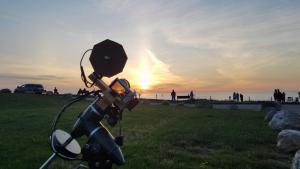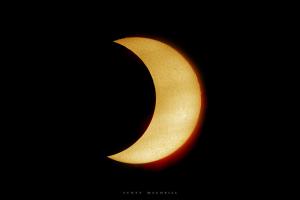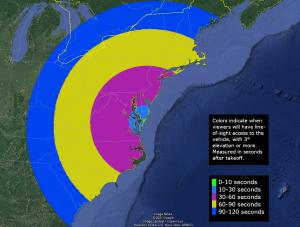Celebration of Space - June 11, 2021
![A fantastic image of the Sunrise Solar Eclipse of 2021 over Massachusetts by <a href='https://www.facebook.com/christine.rhubarb?comment_id=Y29tbWVudDo0MzA1MTU2NDI2MTYzMzQwXzQzMDUxNjgzNTYxNjIxNDc%3D&__cft__[0]=AZWMtrH2VNDrX4NFxJ4-NxNjSQYKC-y2PgLS_GxM2eMLpmXdrA6UAVil_vBBo-hXxSERURJ9f939wccjZi8DDHrJUYTyDl-Ukjq96VV8oBD8CbCK44XARcU0-KnSogS8RwDFDTp0QFpxUykGk89UoI-rOA59-OQkur8fxZVU4F2KnlnwTrJ6Y1dkcVNpQ4OUb74&__tn__=R]-R' title='Christine Rhubbarb'>Christine Rhubbarb</a>](/images/publications/50905d7b2216bfeccb5b41016357176b/large/2021.06.10-Solar_Eclipse_Horns_1623433204.jpg)
A fantastic image of the Sunrise Solar Eclipse of 2021 over Massachusetts by Christine Rhubbarb
On Thursday morning, June 10, 2021, we experienced a fantastic sunrise solar eclipse in New England. Frosty Drew Astronomers Derek Schacht and Scott MacNeill were set up about 0.25 miles apart at Point Judith, Rhode Island. We had telescopes fitted with cameras and were live streaming the eclipse to the Frosty Drew YouTube channel. The view was amazing! While waiting for the Sun to rise we experienced a stunning sunrise of yellows, pinks, and reds. About 15 minutes before sunrise a stunning solar pillar appeared jetting up from the horizon. This happens due to thin clouds and humidity in the atmosphere that scatter sunlight. Once the Sun rose, we had about 5 minutes of the Sun being obscured by clouds low on the horizon, after which the eclipsed Sun emerged. From that point until the end of the eclipse, the view remained largely cloud free, with only a few wispy clouds remaining.
We were both quite surprised at how unattended our location was during the eclipse. It’s no secret that Point Judith has the best view of sunrises and sunsets in Rhode Island, and from the Fisherman’s Memorial you have a 360° view of the horizon. I arrived around 2:00 am to guarantee a front spot at the Memorial site. Which was completely unnecessary as only two other individuals were present during the eclipse. What really surprised me about the lack of interest is that, in comparison, this eclipse was much better than the solar eclipse of August 2017 for New England based viewers! Even our live stream was lightly attended.
We speculate that this may be the result of limited media coverage of the event. The 2017 solar eclipse had a path of totality that crossed the United States. The path of totality is where you would have to be located to see a total solar eclipse. Thursday’s eclipse was an annular solar eclipse, and the location to actually see the annular part of the eclipse was not over the United States. Potentially resulting in much less media hype. In New England, the 2017 eclipse maxed out at about 67% partial eclipse. Thursday’s eclipse maxed out at near 72% partial eclipse. We also speculate that the early showing of the eclipse, which was 5:12 am – 6:30 am, was just too early for many to head out to a viewing location. I had brought a bunch of eclipse glasses with me, just in case other viewers did not have any. Though they sat in their box the entire time.
Regardless, it was a spectacular event, and we captured many images and video of the eclipse. Be sure to visit our gallery of the eclipse. We will be adding additional images over the next week or so. Also, take a moment to experience the event via the archived version of our live stream. The next solar eclipse that will happen over our region will be on Saturday, October 14, 2023.
Starting next Friday, June 18, 2021, the Chinese Space Station (Tianhe-1) will commence morning pre-dawn passes over the Northeast. We usually don’t report morning passes of satellites, as they are much harder to see from a scheduling perspective, though Tianhe is a new addition to humanity’s space-based residencies, so we are dropping this quick heads up for early morning risers, or astro-geeks that are packing up in pre-dawn light. Visit the Frosty Drew Satellite Prediction Utility for daily pass times over our region.
This coming Tuesday morning, June 15, 2021 at 7:00 am ET the Northrop Grumman’s large Minotaur 1 rocket will launch from the Wallops Flight Facility in VA. This launch, though after sunrise, should be visible to the entire Southern New England area, if you have a low enough view of the southern horizon. Set out to a location with a good view of the south → south east horizon and be there 10 minutes before launch. Look for what appears to be a bright object moving rather quickly about 3° (or more) over the horizon on an easterly track. The rocket will be carrying national security payloads for the National Reconnaissance Office. If you catch a video or photo of the launch, post it to our Facebook or Twitter (@FrostyDrewOBSY) and we will share it on our social media.
On Monday, June 7, 2021, the NASA Juno Mission, which is currently orbiting Jupiter, performed the closest flyby of Jupiter’s largest Moon – Ganymede in over two decades. During the flyby Juno’s cameras were firing away capturing images in several wavelengths. At this time, only the green channel image has been returned, and it looks amazing, even though it’s just greyscale! Check out the stunning image here. Over the next couple of days, Juno will transmit additional wavelengths of the same image, including the blue and red wavelengths. After which, a color version of that image will be available. Ganymede is not only Jupiter’s largest moon, but also the largest moon in the Solar System. Coming in at about 75% the size of Mars. We often view Ganymede among the other Galilean Moons of Jupiter at Frosty Drew Observatory, and we have it on the list of targets for our Summer Stargazing Nights this year.
Enjoy your last full week of spring in the Northern Hemisphere, because summer kicks in overnight on June 20th when the Summer Solstice occurs. But we will write more about that next week.
- Author:
- Scott MacNeill
- Entry Date:
- Jun 11, 2021
- Published Under:
- Scott MacNeill's Columns




